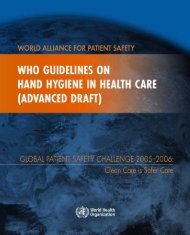Adverse event reporting.pdf
Adverse event reporting.pdf
Adverse event reporting.pdf
You also want an ePaper? Increase the reach of your titles
YUMPU automatically turns print PDFs into web optimized ePapers that Google loves.
tems failures, with the goal of redesigning systems to reduce the likelihood of patient<br />
injury. The key conceptual point here, and the heart of a non-punitive approach to<br />
error <strong>reporting</strong>, is the recognition that adverse <strong>event</strong>s and errors are symptoms of<br />
defective systems, not defects themselves. Reporting, whether retrospective (adverse<br />
<strong>event</strong>s and errors) or prospective (“hazards”, or “errors waiting to happen”) provides<br />
the entry point into investigation and analysis of systems’ defects, which, if skillfully<br />
done, can lead to substantial system improvements. Reporting is one way to get this<br />
type of information, but not the only way (see Section 4).<br />
Ideally, internal <strong>reporting</strong> systems should go hand in hand with external <strong>reporting</strong><br />
systems, by identifying and analysing <strong>event</strong>s that warrant forwarding to external<br />
<strong>reporting</strong> agencies. Conversely, external <strong>reporting</strong> systems are most effective when<br />
they are an extension of internal systems.<br />
Process<br />
What is reported<br />
Types of reports<br />
Reporting systems may be open-ended and attempt to capture adverse <strong>event</strong>s and<br />
close-calls along the entire spectrum of care delivery, or may focus on particular<br />
types of <strong>event</strong>s, such as medication errors or pre-defined serious injuries. In general,<br />
focused <strong>reporting</strong> systems are more valuable for deepening the understanding of<br />
a particular domain of care than for discovering new areas of vulnerability. While<br />
these guidelines focus on <strong>reporting</strong> systems related to adverse <strong>event</strong>s and medical<br />
errors, other types of health-related <strong>reporting</strong> systems focus on medical devices,<br />
epidemiological outcomes such as emergence of antimicrobial resistance, post-marketing<br />
medication surveillance, and specific areas such as blood transfusions.<br />
Formats and processes vary from prescribed forms and defined data elements<br />
to free-text <strong>reporting</strong>. The system may allow for reports to be submitted via mail,<br />
telephone, electronically, or on the World Wide Web.<br />
Types of <strong>event</strong>s<br />
<strong>Adverse</strong> <strong>event</strong>s. An adverse <strong>event</strong>s is an injury related to medical management,<br />
in contrast to a complication of disease (6).Other terms that are sometimes used<br />
are “mishaps”, “unanticipated <strong>event</strong>s” or “incidents”, and “accidents”. Most authorities<br />
caution against use of the term accident since it implies that the <strong>event</strong> was<br />
unpr<strong>event</strong>able.<br />
<strong>Adverse</strong> <strong>event</strong>s are not always caused by an error. For example, one form of<br />
adverse drug <strong>event</strong>, “adverse drug reaction” is, according to the WHO definition, a<br />
complication that occurs when the medication is used as directed and in the usual
















